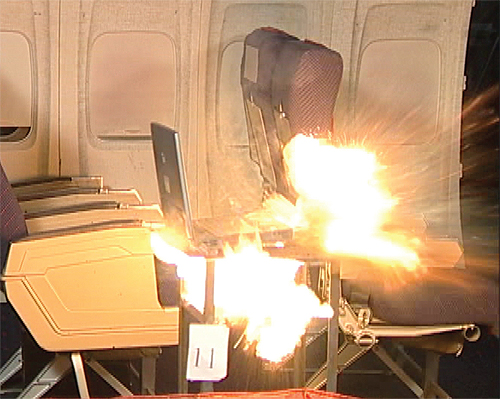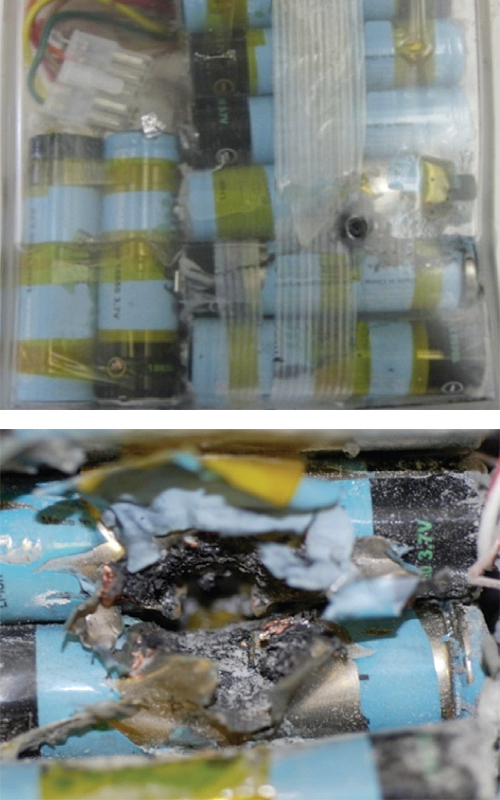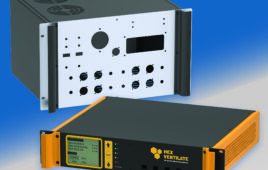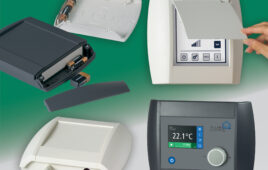Leslie Langnau, Managing Editor
Rechargeable lithium-ion batteries are fast becoming the power source of choice. These lightweight and long lasting batteries are often chosen for use in many consumer, automotive, medical, and defense products. Their low self-discharge rate, compared to other battery types, makes them ready to use when you need them.
The high-energy density of lithium-ion batteries is not without risk, though. Protections built into lithium-ion batteries help maintain their safety during normal use. It’s when abnormalities occur—such as manufacturing defects, excessive temperature elevation, and penetration by outside materials— that these batteries can become hazardous.

Lithium-ion batteries still have some risk of explosion if enough microscopic metal particles converge within the cell, resulting in an electrical short.
In fact, if enough microscopic metal particles converge within the cell, an electrical short can develop, resulting in the elevation of the battery’s temperature to dangerous levels. This can lead to thermal runaway, and cause the battery to ignite or explode.
As a precaution, the U.S. Department of Transportation has placed limitations on the types and sizes of lithium-ion batteries allowed in checked and carry-on baggage.
Given the vast number of these batteries in use worldwide, the energy storage system malfunctions only on rare occasion. Even so, lithium-ion battery safety remains a top priority for a number of applications across markets such as:
- Automotive: hybrid electric vehicles, electric vehicles
- Consumer: cell phones, MP3 players, digital cameras, PCs, power tools, remote-control toys
- Defense: battlefield electronics used by dismounted soldiers
- Medical: portable monitoring devices, automated external defibrillator
- Aviation: aircraft power, drones
Built-in lithium-ion battery manufacturing precautions have reduced risks to property and lives. Still, there is ample opportunity to enhance the overall safety of these batteries when major short circuits occur.
One example comes from engineers at Phillips-Medisize who closely researched, evaluated and tested the technology to determine how to minimize its combustibility under catastrophic cell failure.
The two-tiered solution consists of a casing that surrounds the lithium-ion battery cells and a fluid that surrounds the cells. When penetrated, the casing self-seals the opening where, for example, a high-speed projectile enters the energy storage system. The seal limits oxygen to the cells, so resulting flames can’t propagate. The fluid helps disperse the heat from the individual cell to a much larger surrounding area. As a result, it prevents the initially affected cell(s) from reaching a temperature capable of triggering thermal runaway and subsequent fire and explosion.

Engineers at Philips-Medisize developed a self-sealing casing for the batteries that limits oxygen to the cells so that resulting flames cannot propagate.
As a result of this innovation, short-circuited lithium-ion batteries smolder and extinguish, rather than ignite and explode. This solution has the potential to minimize harm to property and lives, while significantly enhancing the safety of devices that run on rechargeable lithium-ion batteries.
Phillips-Medisize
www.phillipsmedisize.com
Filed Under: Uncategorized




Tell Us What You Think!